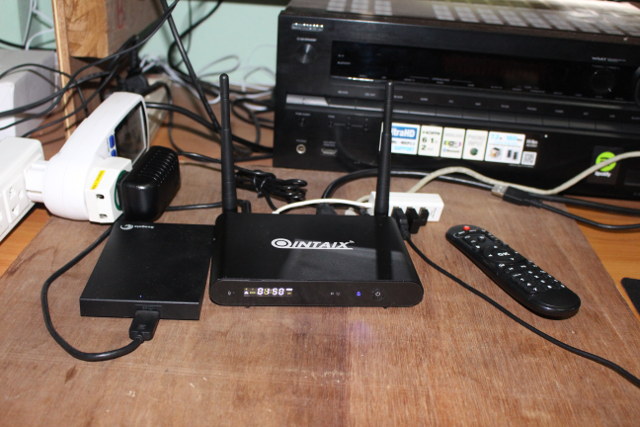Qintaix Q912 is one of the many octa-core Android boxes based on Amlogic S912 processor. I’ve already shown photos of the device and its internal design in the first part of Qintaix Q912 review, so today I’ll report the results of my testing with Android firmware, video & audio capabilities in Kodi 17 Alpha 3 (pre-installed), features supports, benchmarks, and other comment. I will also be interesting to find out how it compares to M12N TV box, also based on Amlogic S912 processor.
First Boot, Settings, and First Impressions
I’ve connected all necessary cables including HDMI and Ethernet, added some USB devices including two 2.4 GHZ USB dongles for my air moues and wireless gamepad, a USB keyboard to take screenshots, and a USB 3.0 hard drive to the USB 2.0 ports of the device. Once you apply power, the LED is turn red, and you need to press the power button on the unit ot the remote control to start the TV box. The front panel display will show “Boot”, and within a typical 40 seconds you should be to the launcher, after which the display will show the current time.
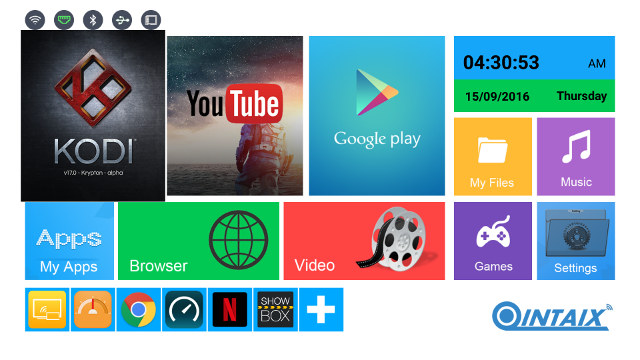
It’s your typical TV launcher with large icon links to common apps or folders of apps (not customizable), and shortcut row will smaller icons that can be added or removed as you wish.
The Settings app is different from M12N. but basically the same as other Amlogic TV boxes.
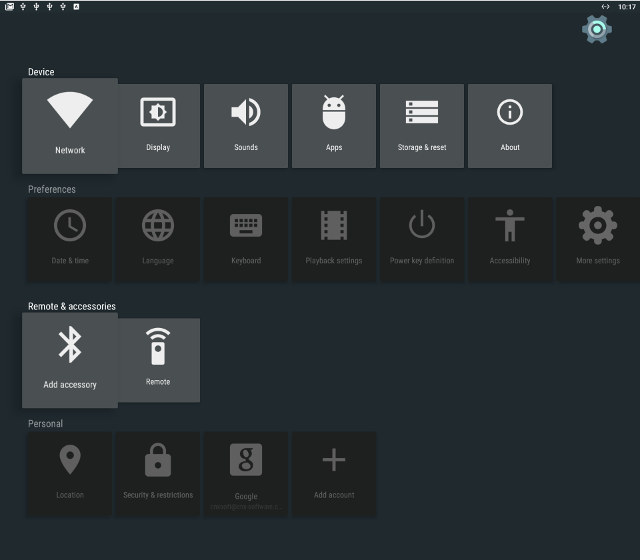
The most relevant / notable settings include:
- Device
- Network – WiFi, Ethernet, and VPN
- Display
- Screen resolution: Auto switch on/off, deep color mode on/off, 1080p24/50/60, 720p50/60, 4k2k 24/25/30/50/60/SMPTE, 576p50, 480p60, 1080i50/60
- Screen position, Day Dream, HDR (Auto, On, Off)
- Sound -> Digital Sounds -> Auto detection, PCM, HDMI, SPDIF
- Preferences
- Playback settings – HDMI self-adaption on/off (aka automatic frame rate switching)
- Power key definition – Suspend and resume, shutdown
- More settings – Access to Android Marshmallow settings
By default, the box will select the high possible resolution on your TV, and for mine to was 4K2K SMPTE (4096×2160 @ 24 Hz), but I switched back to 4K2K-60Hz (3840×2160) for testing. Like with most Amlogic TV box, Qintaix Q912 has problems to remember my settings, and will often revert to 1080p60. One possible reason is that it is connected to an Onkyo A/V receiver before being connected to the TV, and sometimes the receiver is turned on, and other time turned off. Once the receiver is turned on, I can’t turn it off anymore using either its remote control or the power button on the unit, as the box will always turn it back on. That’s a very annoying issue that’s been happening with all recent (Android 6.0) Amlogic TV boxes. This is some HDMI CEC issue, as if I disable HDMI CEC (RIHD) in the receiver the problem goes away. That however means I can’t control the TV over CEC using the receiver’s remote control anymore…
As mentioned in the list of “Notable settings”, we can access Android 6.0 settings through More settings icon, and configure other aspect of the device such as portable hotpost, printer, developer options, accessibility, printing, Languages and Input, etc…
A single 11.49 GB internal partition is used for apps and data, a capacity that should be plenty enough for most people. Just like M12N, Qintaix Q912 is running Android 6.0.1 on top of Linux 3.14.29 as per About Mediabox section. The firmware is rooted. OTA firmware update is currently not supported, but I could install the latest firmware (dated 06 September 2016) via UPDATE&BACKUP app using a USB flash drive. The company also informed me that network firmware updates will be enabled later on.
The included infrared remote control works fine, and I could use it up to 10 meters, where I started getting some misses (maybe 1 out of 10). The IR learning function worked too, as I tested it with the power and volume keys of my TV remote control. I still used MINIX NEO A2 Lite air mouse for the review, since it’s just much more convenient to use that the IR remote control.
The Google Play store worked better than on other box, especially since I could also installed Bluetooth LE apps such as Mi Fit or Smart Movement. I also installed Amazon Underground to play the free version of Riptide GP2 game.
Power handling has been well implemented. The TV box will go into standby after a short press on the power button of the remote control, and into power off mode with a long press. As seen above, you can also configure the short press to go directly into power off mode. You can also turn the TV box back on using the remote control or the power button on the unit
Power consumption figures are also pretty good, since my power meter did not detect any power draw in power off mode, but standby mode appears to be pretty much useless:
- Power off – 0.0 watt
- Standby – 3.1 watts
- Idle – 3.1 watts
- Power off + USB HDD – 0.0 watt
- Standby + USB HDD – 5.1 watts
- Idle + USB HDD – 5.1 watts
As we’ve seen with the teardown, Qintaix Q912 comes with a heatsink on top of Amlogic S912 processor, as well as a metallic enclosure, but the board is not in contact with the case at all. Still, during use the case feels fairly hot, and actually feeling hotter at the touch that what my IR thermometer is reporting with top and bottom temperatures of 40 and 44 °C max after Antutu 6.2, and about 43°C and 46°C respectively after playing Riptide GP2 for 15 minutes.
I did not find any major issues with Qintaix Q912 firmware, which I found fast and very stable, although I still got a couple of “Unresponsive app”. I also like that they kept the notification bar, albeit removed the status bar, and they still have that annoying HDMI CEC bug preventing me to turn on my A/V receiver. The device also have the exact some IPTV apps, namely FilmOn, Modbro, and Showbox, that I covered in MXQ Plus M12N TV box review.
Video and Audio Playback with Kodi 17, Antutu Video Tester, and DRM info
Contrary to most other TV boxes I’ve reviewed which come with the stable version of Kodi, currently Kodi 16.1, or somethimes a fork, Qintaix Q912 is pre-loaded with Kodi 17.0 Alpha 3 built on July 31st.
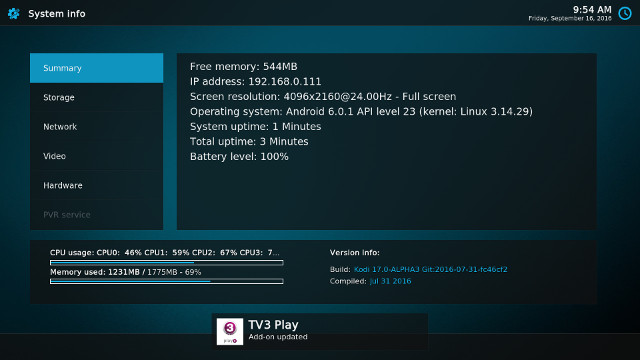
And like many TV box, they’ve also installed piracy add-ons, many of which are not working…
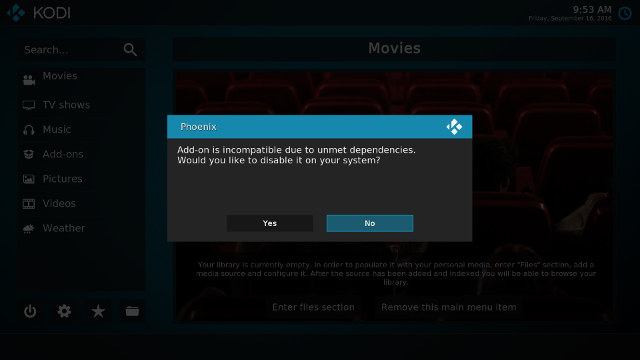 Anyway, I’m only testing local video playback in Kodi, and I’m done so from a SAMBA share using the Gigabit Ethernet connection.
Anyway, I’m only testing local video playback in Kodi, and I’m done so from a SAMBA share using the Gigabit Ethernet connection.
Most Big Buck Bunny videos from Linaro media samples and Elecard are playing just fine:
- H.264 codec / MP4 container (Big Buck Bunny) – 480p/720p/1080p – OK
- MPEG2 codec / MPG container – 480p/720p/1080p – OK
- MPEG4 codec, AVI container 480p/720p/1080p – OK
- VC1 codec (WMV) – 1080p – 480p/720p/1080p – OK
- Real Media (RMVB), 720p / 5Mbps – Could be a little smoother (software decode)
- WebM / VP8 – 480p/720p: OK (ff-vp8 software decode); 1080p: not smooth
- H.265 codec / MPEG TS container – OK
Automatic refresh rate switching is not working in Kodi 17.0, at least in this device.
Videos with various bitrates were next:
- ED_HD_10Mbps_1080p_MPEG-4.avi (MPEG-4 / 10 Mbps) – Not smooth at all, barely watchable (msmpeg4v2 software decode)
- big_buck_bunny_1080p_surround.avi (1080p H.264 – 12 Mbps) – OK
- h264_1080p_hp_4.1_40mbps_birds.mkv (40 Mbps) – OK
- hddvd_demo_17.5Mbps_1080p_VC1.mkv (17.5Mbps) – Won’t play
- Jellyfish-120-Mbps.mkv (120 Mbps video without audio) – OK
Dolby Digital and DTS support was tested with four use case: PCM 2.0 output (stereo downsampling) or HDMI audio pass-through via Onkyo TX-NR636 A/V receiver, using Kodi and MoviePlayer apps.
| Audio Codec in Video | PCM 2.0 Output (Kodi 17 Alpha 3) |
PCM 2.0 Output (MoviePlayer) |
HDMI Pass-through (Kodi 17 Alpha 3) |
HDMI Pass-through (MoviePlayer) |
| AC3 / Dolby Digital 5.1 | Audio OK but video not smooth | No audio | Audio OK (Dolby D 5.1), video not smooth | OK |
| E-AC-3 / Dolby Digital+ 5.1 | OK | No audio | OK | OK |
| Dolby Digital+ 7.1 | OK | No audio | PCM 2.0 | Video plays in fast forward, without time to setup audio |
| TrueHD 5.1 | OK | No audio | PCM 2.0 | TrueHD 5.1 |
| TrueHD 7.1 | OK | No audio | PCM 2.0 | TrueHD 7.1 |
| Dolby Atmos 7.1 | OK | No audio | PCM 2.0 | Dolby D 5.1 – continuous beep |
| DTS HD Master | OK | No audio | Black screen, no audio | DTS 5.1 |
| DTS HD High Resolution | OK | No audio | Black screen, no audio | DTS 5.1 |
| DTS:X | OK | No audio | Black screen, no audio | DTS 5.1 |
Results are pretty much the same as other Amlogic Android 6.0 TV boxes.
For most videos, 4K video playback is not too bad in Kodi 17.0:
- HD.Club-4K-Chimei-inn-60mbps.mp4 – Not always smooth
- sintel-2010-4k.mkv – OK
- Beauty_3840x2160_120fps_420_8bit_HEVC_MP4.mp4 (H.265) – OK
- Bosphorus_3840x2160_120fps_420_8bit_HEVC_MP4.mp4 (H.265) – OK
- Jockey_3840x2160_120fps_420_8bit_HEVC_TS.ts (H.265) – OK
- MHD_2013_2160p_ShowReel_R_9000f_24fps_RMN_QP23_10b.mkv (10-bit HEVC) – OK
- phfx_4KHD_VP9TestFootage.webm (VP9) – OK
- BT.2020.20140602.ts (Rec.2020 compliant video; 36 Mbps) – OK.
- big_buck_bunny_4k_H264_30fps.mp4 – Some frames are “jumping”
- big_buck_bunny_4k_H264_60fps.mp4 – Not smooth, and audio delay (as expected since hardware is not supposed to support it)
- Fifa_WorldCup2014_Uruguay-Colombia_4K-x265.mp4 (4K, H.265, 60 fps) – OK
- Samsung_UHD_Dubai_10-bit_HEVC_51.4Mbps.ts (10-bit HEVC / MPEG-4 AAC) – OK
- Astra-11479_V_22000-Canal+ UHD Demo 42.6 Mbps bitrate.ts (10-bit H.265 from DVB-S2 stream) – OK
- -4K.mp4 (10-bit H.264; 120 Mbps) – 0.5 to 1 fps (software decode)
- Ducks Take Off [2160p a 243 Mbps].mkv (4K H.264 @ 30 fps; 243 Mbps; no audio) – Not smooth at all from either HDD or network
- tara-no9-vp9.webm (4K VP9 YouTube video) – OK, except for one massive slowdown for 2 to 3 seconds.
- The.Curvature.of.Earth.4K.60FPS-YT-UceRgEyfSsc.VP9.3840×2160.OPUS.160K.webm (4K VP9 @ 60 fps + opus audio) – OK most of the time, but I can see some frame drops from time to time
The video above were tested using 4K60Hz (3840×2160), and the video show properly, but I previously also tested 4KSMPTE (4096×2160 @ 24 Hz) and some black bands showed on the left and right edges of the TV. You can watch Kodi 17.0 setup and video playback in Qintaix Q912 below.
Blur-ray videos (Sintek-4k.iso & amat.iso) and two MPEG2 1080i videos could play fine. I basically had the same results as on M12N for 10-bit H.264 videos with a 720p sample playing fine, but a 1080p sample not being smooth enough. Kodi 16.1 would enable subtitles by default in those two videos, but Kodi 17.0 Alpha 3 requires the user to manually enable subtitles.
LG 42UB820T Ultra HD television does not support 3D videos, but my Onkyo TX-NR636 A/V receiver does, and could detect 3D content (3D icon on) for MVC videos as shown in Zidoo X1 II review, and for others it’s still interesting to see if the box can decode them:
- bbb_sunflower_1080p_60fps_stereo_abl.mp4 (1080p Over/Under) – OK
- bbb_sunflower_2160p_60fps_stereo_abl.mp4 (2160p Over/Under) – Won’t play at all
- Turbo_Film-DreamWorks_trailer_VO_3D.mp4 (1080p SBS) – OK
- 3D-full-MVC.mkv (Full-frame packed MVC 3D MKV) – 2D only, 3D icon not shown on AV receiver
- ISO-full3D-sample.iso (Full-frame packed MVC 3D ISO) – 2D only, 3D icon not shown on AV receiver
I also played one complete 1080p H.264 video for 2 hours without issues through the network (SAMBA share), and I completed Kodi 17 testing by check out various video from my library with IFO, MKV, AVI, MP4, XViD/DViX, and MKV 720p and 1080p videos. Most could play just fine, but I noticed some FLV video had no audio, and IFO/VOB files would not play smoothly at all.
MXQ Plus M12 previously achieved 865 points in Antutu Video Tester 3.0 benchmark, and Qintaix Q912 got a slightly lower score with 849 points.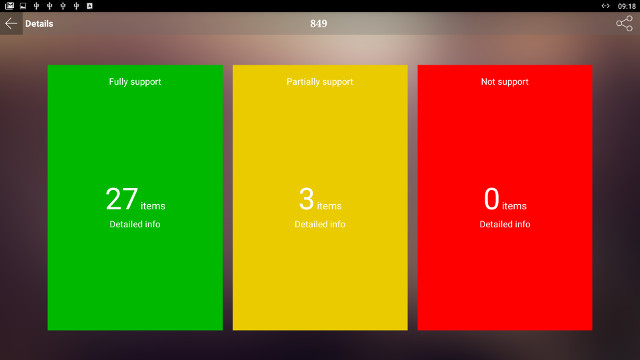 The three “partially support” videos could not play smoothly enough.
The three “partially support” videos could not play smoothly enough.
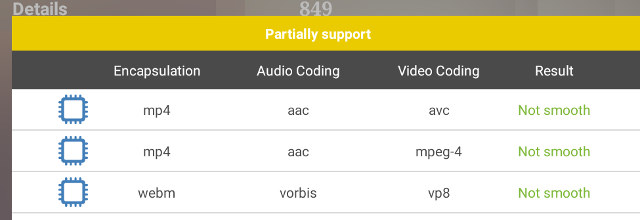 DRM info reports Widevine Level 3 is supported.
DRM info reports Widevine Level 3 is supported.
I also quickly tested YouTube, and it supports up to 1080p. Video samples can be downloaded via links in the comments section of that video sample post.
Network Performance for WiFi and Ethernet
Qintaix Q912 has a dual band WiFi module (AP6330), and I could connect to both 2.4 and 5.0 GHz access point, but no support for 802.11ac, so I only tested performance of 802.11n @ 2.4 GHz by copying a 278MB file between a SAMBA share and the internal storage several times in either direction. The result is disappointing since the transfers averaged 1.69 MB/s, one of the poorest results among the devices I’ve tested. At least, even if the performance is far from outstanding, WiFi is very stable.
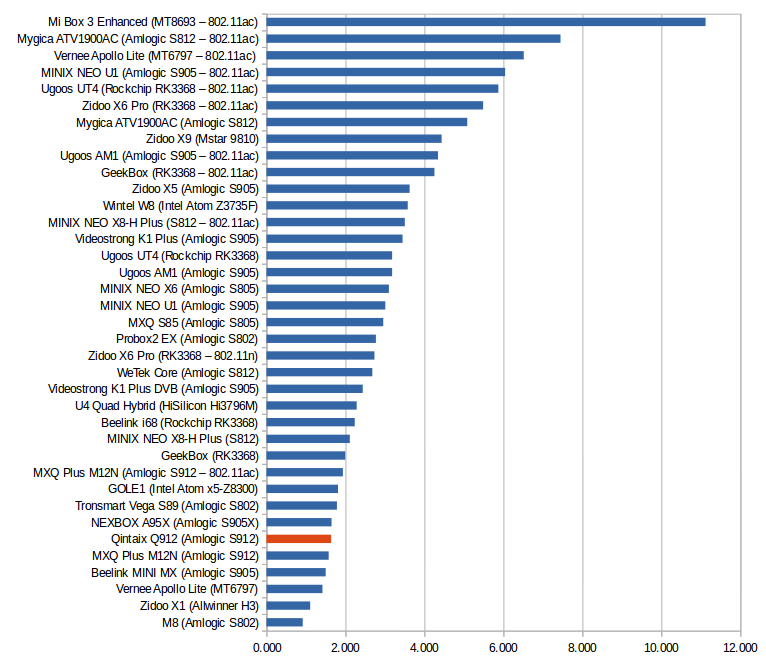
There’s also some asymmetry between download and upload speeds, with the former reaching about 2 MB/s. You may have noticed two external antennas on Qintaix Q912, but one of them is not connected to anything, and is only there to make the box prettier.
I found Gigabit Ethernet to be working well, and tested full duplex performance with “iperf -t 60 -c server_ip -d” command line:
|
1 2 3 4 5 6 7 8 9 |
[ 4] local 192.168.0.104 port 5001 connected with 192.168.0.111 port 39389 ------------------------------------------------------------ Client connecting to 192.168.0.111, TCP port 5001 TCP window size: 246 KByte (default) ------------------------------------------------------------ [ 6] local 192.168.0.104 port 57724 connected with 192.168.0.111 port 5001 [ ID] Interval Transfer Bandwidth [ 6] 0.0-60.0 sec 2.93 GBytes 419 Mbits/sec [ 4] 0.0-60.0 sec 3.42 GBytes 489 Mbits/sec |
It’s not exactly reaching 1 Gbps, but in a TV box it should not matter than much, especially the device/SoC only support USB 2.0 ports.
Miscellaneous Tests
Bluetooth
I could easily pair Vernee Apollo Lite smartphone to the box, and transfer a few pictures over Bluetooth, however I was not so lucky with my Bluetooth 3.0 headet (Sport-S9) which was not detected at all, and a Bluetooth 4.0 LE fitness tracker that was detected, but the TV box asked me for a pin number, which usually is not the case for this device, and pairing failed. I tried a few times and different pin code, and after pressing Cancel, the device (SH09) was shown to be paired… Sadly Smart Movement app used with the tracker would not find the device at all.
Since the firmware is rooted, I also tried my PS3 wireless gamepad clone with Sixaxis Compatibility Checker, and I could configure and use the game controller.
Storage
I used a 1TB Seagate USB hard drive set-up with 4 partitions, and a FAT32 micro SD card to test file system support.
| File System | Read | Write |
| NTFS | OK | OK |
| EXT-4 | Not mounted | Not mounted |
| exFAT | OK | OK |
| BTRFS | Not mounted | Not mounted |
| FAT32 | OK | OK |
I also use A1SD bench app to test the two partitions on the USB hard drive (NTFS & exFAT), and read speed was OK for both (NTFS: 34.88 MB/s; exFAT: 39.88 MB/s), but write speed is better on NTFS: 16.08 MB/s vs 4.83 MB/s. I had to test exFAT on two different days. The first day I only got R: 4.83 MB/s; W: 0.97 MB/s, after running the benchmark twice on the partition, maybe because another process was busy going through the file system…
I ran A1SD bench again to evaluate internal storage performance, and sequential read and write speeds were decent at 40.36 MB/s and 12.94 MB/s respectively.
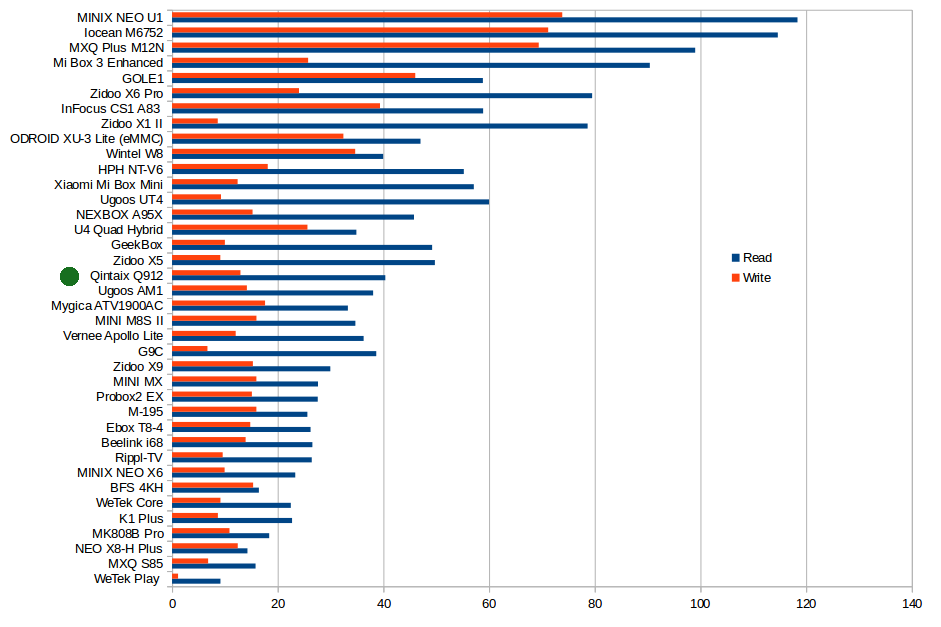
Gaming
I’ve detailed gaming on Amlogic S912 using M12N TV box, and last time I could clearly see a different in performance between Amlogic S905 and Amlogic S912, although games like Riptide GP2 were still not clearly as fluid as on Xiaomi Mi Box 3 Enhanced. So I expected the same results on Qintaix Q912, but I have to say performance feel just like on Amlogic S905 here: Candy Crush Saga and Beach Buggy Racing are both very smooth, but Riptide GP2 using max resolution settings had a lower framerate closer to Amlogic S905. Still performance was stable throughout my 15 minutes playing the game.
Qintaix Q912 Benchmarks
CPU-Z detects an octa-core Cortex A53 @ up to 2.02 GHz with a Mali-T820 GPU. The info is correct from the Linux kernel point of view, but as we’ve previously seen Amlogic S912 is most likely running at 1.5 GHz maximum here.
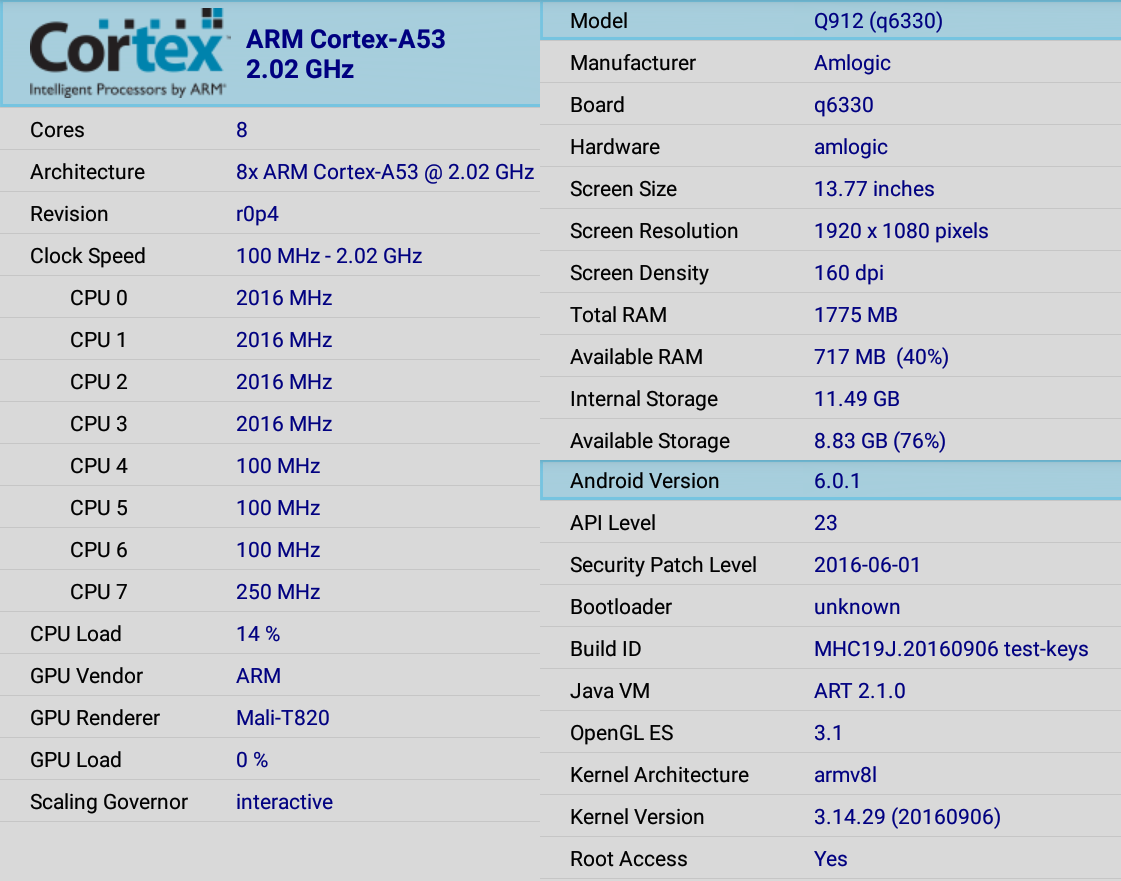
The device’s board is q6330, an information that can be useful if you want to try alternative firmware. Resolution is 1920×1080, total RAM 1775 MB as some is used by the GPU and/or GPU, and internal storage has a 11.49 GB capacity as reported above.
I was disappointed by Amlogic S912 benchmarks in M12N TV box, so I was expecting a little more in Qintaix Q912, but on the contrary the score was even lower at 35,966 points in Antutu 6.2.
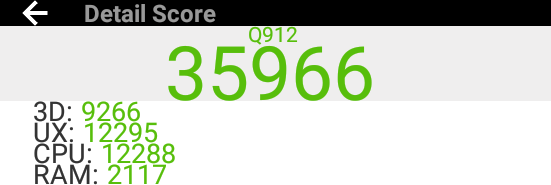
Scores in Vellamo were also lower for Metal (787 vs 1,052)and Browser (2,336 vs 2,758), but better for multicore (1,422 vs 1,130) likely because Qintaix Q912 passed all tests, but M12N failed one.
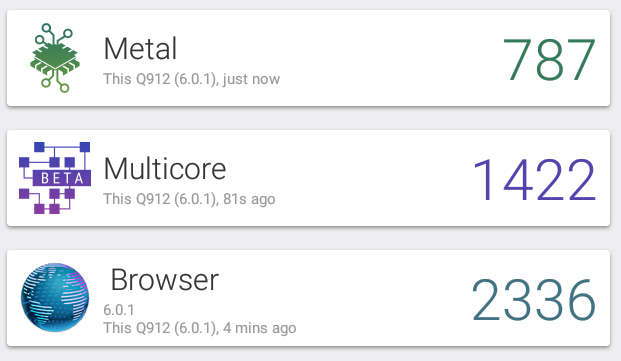
3Dmark Ice Storm Extreme confirmed the lower performance in benchmark with 4,713 points against 5,752 points in MXQ Plus M12N.
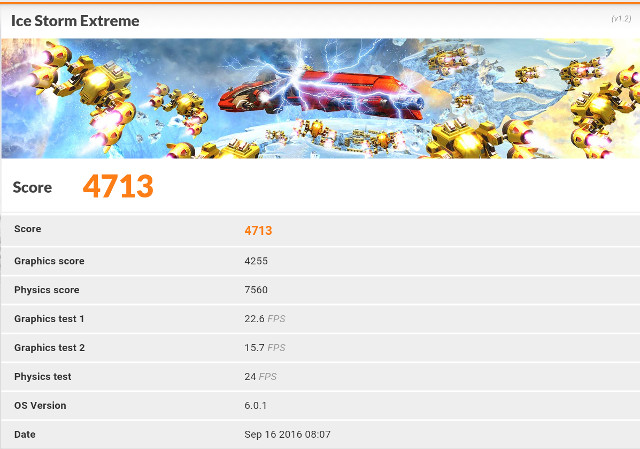
That may explain why gaming did not feel thtat good. For reference, Amlogic S905 TV boxes typically achieve about 4,300 points.
Conclusion
Qintaix Q912 TV box works reasonably well overall, but they’ve decided to use Kodi 17.0 Alpha 3 which does not bring much compare to Kodi 16.1, and does not perform as well with all video. Once we dig into benchmarks and play game, we also quickly realize the TV box has about the same performance as Amlogic S905 devices, meaning you pay a premium without any obvious benefits.
PROS
- Recent Android 6.0 firmware that is both responsive and stable, and includes a slightly different launcher
- Mostly fine 4K video support for VP9, H.265 and H.264 codecs in Kodi 17
- HDMI audio pass-through for Dolby 5.1, DTS 5.1, and TrueHD 5.1 and 7.1 in Video MoviePlayer
- Proper power handling, and low power off & idle power consumption
- exFAT, NTFS, and FAT32 file system support for external storage
- IR remote control working up to at least 10 meters
- Google Play Store support better than some other device (e.g. for Bluetooth LE app)
- Bluetooth file transfer and Sixaxis controller (PS3 gamepad) working
- Metal case with front panel display showing time
CONS
- HDMI audio pass-through and automatic frame rate switching not working properly in Kodi, and DTS-HD even lead to black videos with no audio at all. Dolby Atmos and DTS-HD 7.1 not supported in other apps
- Kodi 17.0 Alpha 3 used in the firmware does not handle video playback of all videos as well as Kodi 16.1 (stable version): e.g. issues with VOB, no audio in FLV, etc…
- Performance equivalent to quad core Amlogic S905 TV boxes according to benchmarks and gaming experience
- HDMI output mode is often falling back to 1080p60, even when manually set to 4K 60Hz. (The system may be confused when I turn on the TV or AV receiver on and off).
- WiFi: Mediocre yet stable (e.g. no stall) WiFi performance. Only one external antenna used out of the two external antennas.
- HDMI CEC not disabled by default and no CEC option. HDMI CEC bug keeping my A/V receiver on.
- Bluetooth: BT 3.0 audio headset not found at all, Bluetooth LE fitness tracker detected, but pairing fails, and app can’t sync.
- DRM: Only supports Widevine Level 3
- Dolby & DTS licenses not included (Only a problem for apps other than Kodi, for people not using HDMI or S/PDIF audio pass-through). This would require Amlogic S912-H processor.
I’d like to thank Qintex Tech for sending a review sample, and if you plan to order in quantities, you can do so directly from the company. The TV box can also be found on Aliexpress for $73.50 and up, or Amazon US for $122.

Jean-Luc started CNX Software in 2010 as a part-time endeavor, before quitting his job as a software engineering manager, and starting to write daily news, and reviews full time later in 2011.
Support CNX Software! Donate via cryptocurrencies, become a Patron on Patreon, or purchase goods on Amazon or Aliexpress


